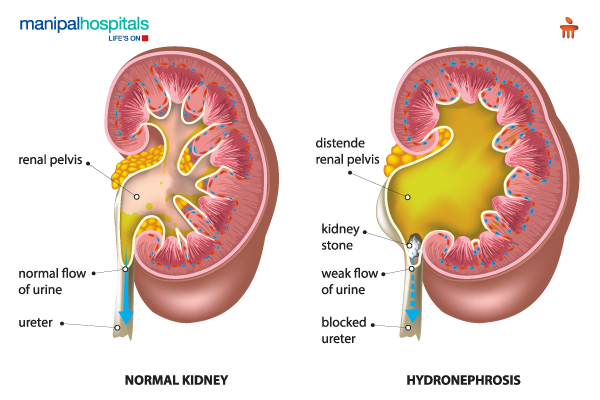
Kidneys are vital organs that filter waste and extra fluids from the body, helping maintain a healthy internal balance. But what happens when urine cannot pass properly from the kidney to the bladder? This is where Kidney hydronephrosis comes in—a condition where the kidney swells due to urine build-up.
Although the term may sound complicated, it's a fairly common condition that requires medical attention. Let’s explore what Kidney hydronephrosis is, how it affects your health, its causes, and the most effective ways to treat it.
Synopsis
What is Kidney Hydronephrosis?
Kidney hydronephrosis is a condition where one or both kidneys become swollen due to a blockage or obstruction in the urinary tract that prevents urine from draining into the bladder. This leads to a backflow of urine, increasing pressure and causing the kidney(s) to enlarge.
The condition can affect one kidney (Left kidney hydronephrosis or Right kidney hydronephrosis) or both. It can also develop suddenly (acute) or gradually over time (chronic).
Hydronephrosis is not a disease itself but a sign of an underlying issue that needs to be identified and treated.

What Causes Hydronephrosis in the Kidney?
There are several causes of hydronephrosis in the kidney, ranging from temporary blockages to more serious medical conditions. Understanding these causes helps in determining the right course of treatment.
Here’s a helpful table summarising the common causes, who is most affected, and whether the condition is reversible:
|
Cause |
Who it Affects |
Reversible? |
|
Adults |
Yes, with treatment |
|
|
Urinary tract infections |
All age groups |
Yes |
|
Congenital abnormalities |
Newborns and infants |
Sometimes |
|
Enlarged prostate |
Older men |
Often |
|
Tumours or cancer |
Adults |
Depends on diagnosis |
|
Pregnant women (temporary) |
Usually |
Each of these can lead to Kidney hydronephrosis by creating a physical or functional block in the urinary pathway.
What are the Symptoms?
Symptoms of Kidney hydronephrosis can vary depending on the severity and whether one or both kidneys are affected.
Common signs include:
-
Flank pain or discomfort on one side (may indicate Left kidney hydronephrosis or Right kidney hydronephrosis)
-
Difficulty or pain during urination
-
Frequent urge to urinate
-
Fever and chills (if infection is present)
-
Nausea and vomiting
-
Blood in the urine
Sometimes, especially in mild or early cases, there may be no noticeable symptoms. That’s why routine imaging or checkups can play a big role in early diagnosis.
Is Kidney Hydronephrosis a Serious Condition?
Kidney hydronephrosis can be serious, especially if not addressed promptly. While some cases are mild and resolve on their own, others may lead to permanent kidney damage, recurrent infections, or even kidney failure if left untreated.
The seriousness depends on:
-
The cause: A temporary blockage from a stone may not be as serious as a tumour compressing the ureter.
-
Duration: Long-standing Kidney hydronephrosis is more likely to damage the kidney.
-
Severity: Complete obstruction is more dangerous than partial blockage.
-
Presence of infection: When infection is present along with Kidney hydronephrosis, the condition becomes more urgent and may require hospitalisation.
Therefore, while not every case of Kidney hydronephrosis is dangerous, it should never be ignored. Early diagnosis and kidney hydronephrosis treatment can prevent complications.
How is it diagnosed?
To diagnose Kidney hydronephrosis, doctors typically use a combination of imaging and lab tests, including:
-
Ultrasound – First-line tool to detect kidney swelling
-
CT Scan or MRI – To assess the cause and severity
-
Urine tests – To detect infection or blood
-
Blood tests – To evaluate kidney function
In children or pregnant women, specialised imaging techniques may be used to minimise exposure while ensuring accurate results.
Kidney Hydronephrosis Treatment Options
The main goal of kidney hydronephrosis treatment is to relieve the obstruction and restore normal urine flow. The choice of treatment depends on the causes of hydronephrosis in the kidney and its severity.
-
Medication: If the cause is an infection, antibiotics are prescribed. Painkillers may also be given to manage discomfort.
-
Catheterisation or stent placement: In some cases, a nephrostomy tube (a tube inserted into the kidney to drain urine externally) or ureteral stent (placed inside the ureter) is used to temporarily relieve the obstruction.
-
Surgical intervention: For persistent or structural problems, surgery may be required. This could involve removing stones, correcting anatomical defects, or removing tumours.
-
Monitoring: In mild cases, especially in pregnancy or in infants, careful observation with regular ultrasounds may be enough.
Proper kidney hydronephrosis treatment depends on early detection and a clear understanding of the causes of hydronephrosis in the kidney.
Can It Be Prevented?
While not all cases are preventable, you can reduce your risk by:
-
Drinking enough water daily
-
Treating urinary infections early
-
Managing conditions like an enlarged prostate or kidney stones
-
Getting regular checkups, especially if you’re pregnant or have a history of kidney issues
If you’ve previously had Kidney hydronephrosis, it's essential to follow up regularly with your doctor to prevent recurrence.
Emotional Impact of Breast Cancer Recurrence
Facing the possibility or reality of a recurrence can bring a wave of emotions: anxiety, fear, anger, or even guilt. It's essential to understand that emotional health is just as important as physical health.
Here’s how to navigate the mental health side of survivorship:
-
Talk to a counsellor, psychologist, or therapist with experience in oncology.
-
Join a support group—online or in person—of fellow survivors.
-
Keep a journal to process your emotions and track physical symptoms.
-
Don’t hesitate to lean on family or friends, but set boundaries when needed.
Conclusion
Kidney hydronephrosis is a condition that may seem minor at first but can lead to serious health issues if not addressed in time. Whether you're experiencing early symptoms or have already been diagnosed with Left kidney hydronephrosis, Right kidney hydronephrosis, or any of the causes of hydronephrosis in kidney, timely and expert care is crucial.
At Manipal Hospitals Jaipur, we offer:
-
Advanced diagnostic tools like ultrasound, CT, and MRI
-
24/7 emergency services for urinary blockages
-
A team of experienced urologists and nephrologists
-
Personalised kidney hydronephrosis treatment plans
-
Minimally invasive surgical options
Your kidneys deserve the best care.
Don’t delay—book a consultation today at Manipal Hospitals Jaipur.
FAQ's
In mild cases, especially when caused by temporary conditions like pregnancy or minor urinary tract infections, hydronephrosis may resolve without invasive treatment. However, medical evaluation is essential to rule out more serious causes.
Yes, it can be. Many patients experience flank pain or discomfort on one side, depending on whether the left or right kidney is affected. In some cases, there might be no noticeable symptoms initially.
If not treated timely, it can lead to permanent kidney damage, recurrent infections, or even kidney failure. That’s why early diagnosis and intervention are critical.
In children, it’s often due to congenital abnormalities and may be diagnosed through prenatal or early-life imaging. In adults, common causes include kidney stones, infections, or prostate enlargement.
Most cases respond well to treatment, especially when diagnosed early. Whether it involves medication, stenting, or surgery, the goal is to relieve the obstruction and protect kidney function.





















 6 Min Read
6 Min Read


















